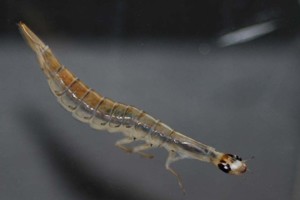
WATCH: UC Researchers Gain Focus on a Bug with Bifocals
University of Cincinnati researchers are reporting on the discovery of a bug with bifocals such an amazing finding that it initially had the researchers questioning whether they could believe their own eyes.
To the best of our knowledge, this is the first demonstration of truly bifocal lenses in the extant animal kingdom,
the researchers state in the Aug. 24 cover feature of the premier life-science journal, Current Biology.
The article is an exploration of two eyes of the larvae of the sunburst diving beetle (Thermonectus marmoratus). The two eyes have the bifocal lens, which the researchers have found in four of the larvaes 12 eyes, says researcher Elke K. Buschbeck, a UC associate professor of biology.
The article explains that using two retinas and two distinct focal planes that are substantially separated, the larvae can more efficiently use these bifocals, compared with the glasses that humans wear, to switch their vision from up-close to distance the better to see and catch their prey, with their favorite food being mosquito larvae.
In addition, we think that within the principle eyes, separate images of the same object could be focused on each of the two retinas, allowing each eye to function as two eyes in one, the researchers reveal in the article. The tubular-shaped eyes with the bifocals allow them to efficiently focus onto their two retinas, says Annette Stowasser, a UC biology doctoral student and first author on the paper.
The discovery was made in Buschbecks lab and was supported by her National Science Foundation CAREER award to recognize the research and teaching talent of young faculty. Were hoping this discovery could hold implications for humans, pending possible future research in biomedical engineering, Buschbeck says.
The discovery could also have uses for any imaging technology, adds Stowasser.
Bugs with Bifocals
The sunburst diving beetle larvae that was studied typically live in creeks and streams around Arizona and the western United States. Its classified as a holometabolous insect the group of insects that morph into something completely different from how they originated like the caterpillar/moth or the maggot/fly. The larvae of these beetles have the bifocal lens. They lose these intricate lenses when they become a beetle.

larva
Researchers Couldnt Believe Their Eyes
As the researchers zeroed in on how the multiple eyes of this insect worked, they did even more research to try to disprove what they saw. They first used a microscope to look through the lenses of the two eyes detailed in the research article. They saw how the lens could make a second image grow sharper something that could only happen with a bifocal. It was my first research project, and I seriously thought I made a mistake, and then we did additional research to try to kill the hypothesis, says Stowasser. However, their findings were confirmed with more research in addition to observing the operation of the lens and the two focal planes via a microscope. They saw the bifocal again when they used a method to project a narrow light beam through the lens. Our findings can only be explained by a truly bifocal lens, write the researchers.
Contributing researchers included Alexandra Rapaport, a UC undergraduate neuroscience major; John E. Layne, UC assistant professor of biological science; and Randy C. Morgan, Invertebrate Conservation program manager for the Cincinnati Zoo & Botanical Garden.

adult beetle
The UC research was supported by Buschbecks $805,000 CAREER award from the National Science Foundation, which was awarded in 2005.
The researchers thank the Cincinnati Zoo and Botanical Garden for providing the original population of sunburst diving beetles for the research.
Related Stories
OTR mural celebrates UC alumni success
April 4, 2025
The UC Alumni Association, UCAA, will mark its annual Alumni Celebration during its upcoming Alumni Week, April 7-13, with a community art project commemorating this year’s slate of alumni honorees receiving the organization’s top awards.
UC Journalism to host Hall of Fame, Young Alumni Awards
Event: April 24, 2025 6:00 PM
The College of Arts and Sciences’ journalism department will host the Hall of Fame and Young Alumni Awards to celebrate the achievements and accomplishments of its graduates. Induction into the UC Journalism Hall of Fame is a special honor reserved for UC alumni who have excelled in the profession of journalism and media, or individuals who have made a significant contribution to journalism at UC.
Bradford pear trees look pretty, smell awful. Why are they...
April 2, 2025
WLWT talks to UC biology Professor Theresa Culley about Ohio's ban on the sale or planting of nonnative and invasive pear trees. The trees are showing up in many parks and wild areas where they are crowding out native species.
